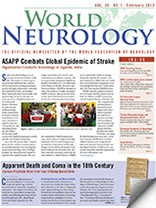Wray SH (2014) Eye Movement Disorders in Clinical Practice. New York NY: Oxford University Press.
By Steven L. Galetta, MD
Eye Movement Disorders in Clinical Practice is written by a legend in the field of neuro-ophthalmology, Dr. Shirley H. Wray. The book is a wonderful compendium of the common and challenging disorders of ocular motility. Chapters are organized topographically beginning with the cortical control of eye movements, followed by chapters on the eyelids, the extraocular muscles and nerves, disorders of horizontal and vertical gaze, dizziness, the cerebellum and ocular oscillations.
Each chapter begins with a generous discussion of the relevant anatomy and physiology of a particular area of the brain. The key anatomical points are then summarized in a box to distill the critical information that is about to be given clinical relevance in the remainder of the chapter. Chapters in this book take some of the most complicated neuroanatomy and make it come to life with beautiful figures, clear discussions and key references. After the anatomy and physiology are reviewed within each chapter, the reader is then taken to cases where the history and examination are dissected, with an emphasis on how signs and symptoms are localized and correlated. Each case has a great video attached to it. The videos are of outstanding quality and clearly demonstrate the ocular motility disturbance. In fact, many cases are the best examples that I ever seen of the eye movement disorder. One minor criticism would be that the videos often do not point out the exact findings as you are taken through the standard neuro-ophthalmological examination. Nonetheless, such findings are summarized in the text and the reader is provided ample guidance on what to look for.
From the video section, the reader is taken back to the text for further discussion of localization, differential diagnosis, testing and treatment of the problem, emphasizing the importance of neuro-ophthalmological signs in managing the patient. The learning experience is then supplemented by special explanatory notes; these break down the problem and often provide some historical context to the findings.
The beauty of this book is its redundancy; the reader is never left to struggle with a single description of the neuro-ophthalmological topic. This is a great feature for both the novice and the expert and makes each case even more memorable.
It was a real pleasure to read this book. There were many moments when I could not put it down because it was fun to read such an organized and a logical approach to eyelid and ocular motility disorders. The chapters on the cortical control of eye movements and the cerebellum are true masterpieces; they take some of the most complicated anatomy and disorders of ocular motility and make them easy to understand. Another feature that makes this book so special is the simple way in which the examination is explained, and how symptoms are emphasized as a guiding factor in what the examiner should look for. I often found myself taking notes on the side, and trying to remember all the gems being offered.
Eye Movement Disorders in Clinical Practice is a keeper! I would recommend it to neurology and ophthalmology trainees and senior clinicians alike.
